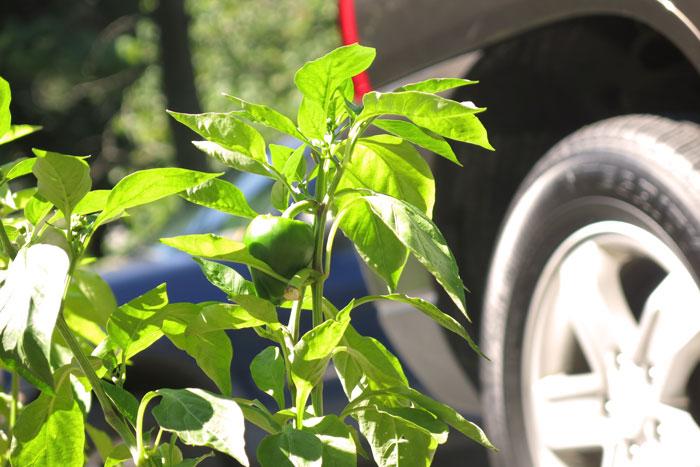Salad Is a Snip Away

Behind 50 Mooreland, peppers line the parking lot. Photo by Christian Moore.
Edible gardens are pretty much everywhere on campus, some in unexpected places
by Tony Moore
The following ran last year, but as the gardens and their available fruits and vegetables change year to year, we thought an update might be helpful. This year's gardens are listed below.
Whether you’re throwing a Frisbee across Morgan Field, sitting outside Rector reading about energy capture and transformation or thinking about lunch while crossing Britton Plaza, you’re likely to see edible gardens sprouting up at every turn.
“The idea came from Randy Nenninger, our recently retired grounds manager,” says Mike Sheaffer, Dickinson’s assistant grounds supervisor. He notes that the program began in 2008 with just a few pepper plants. Since then, the gardens have taken root across campus, a visible—and edible—example of the college's integrated approach to sustainability, and a variety of members of the Dickinson community have enjoyed its fruits.
One such Dickinsonian is Mackenzie Johnson ’16 (Spanish, policy management), who recently wrote an email to Ann Dailey, Dickinson’s master gardener, about just what an impact the gardens can have.
“I just wanted to write you as a Dickinson student who has benefited greatly from the edible gardens you maintain on campus,” Johnson wrote. “And it really brightens my day to find new ones.”

Photo by Luke Moore.
Dailey says that the gardens—available to the entire Carlisle community—have been planted by the grounds crew just about everywhere good light is available, and she notes that everything gets harvested. As for how to harvest, Dailey suggests taking extra care in harvesting vegetables so as not to damage the plants: "Preferably, use scissors or a knife to cut fruits and vegetables from plants,” she says.
With that in mind, here’s Dailey’s list of what is planted and where around campus (summer 2016):
- Kaufman Hall, east entrance: tomatoes (Sun Sugar, Better Boy), peppers (green, Jalapeno), cucumbers, Swiss chard, basil, parsley, thyme, rosemary and sage.
- Britton Plaza, library terraces: tomatoes (Sun Sugar), peppers (Green), Swiss chard, parsley and basil.
- Weiss Center for the Arts, back entrance: tomatoes (Better Boy, Sun Sugar), peppers (Green), cucumbers and squash.
- 50 Mooreland: tomatoes (Sun Sugar, Better Boy), peppers (green), squash, Swiss chard.
- ROTC House: tomatoes (Sun Sugar, Better Boy), peppers (green, cayenne) squash, and cucumbers.
- 41 Conway: tomatoes (Sun Sugar, Better Boy), peppers (green)
And here are Daily's tips for picking and enjoying each kind of vegetable you’ll find:
TOMATOES
- Sun Sugar: Prolific orange/yellow cherry tomatoes that taste like candy to a tomato lover—the ultimate of cherry tomatoes. Harvest often to keep plant producing.
- Better Boy: Classic red tomato with great taste. Usually large 1 lb. when ripe, but weather has played a part and they are ripening smaller this year.
PEPPERS
- Green sweet bell peppers: Many peppers can be harvested at any color but become sweeter as they change color from green to red, purple, orange or yellow depending on the cultivar.
- Jalapeño: This hot chili pepper is usually harvested at four to six inches long and bright green. It can also be harvested when red.
- Cayenne Long Slims: Slender, long peppers that turn bright red when ripe and are very hot. Used in drying, and as a spice.
CUCUMBERS
Marketmore cukes are a mildly sweet, crunchy cucumber that are great sliced and in salads.
SQUASH
Butternut: Taste is similar to a pumpkin, sweet and nutty. It has a yellow skin and orange pulp.
Learn more
Published August 12, 2015